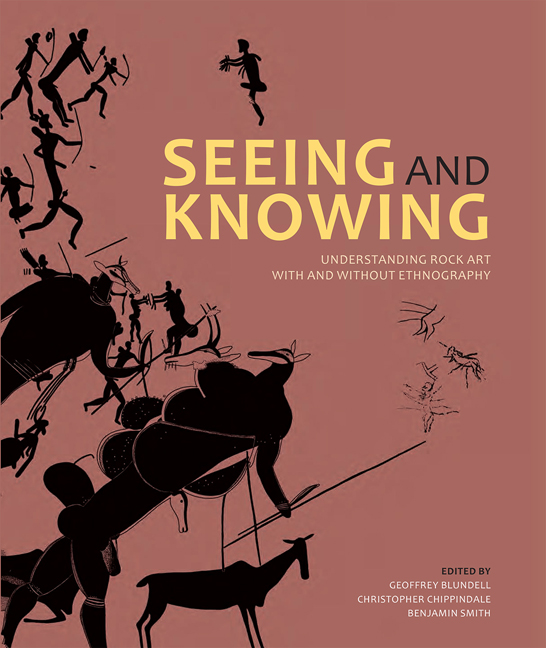Book contents
- Frontmatter
- Dedication
- Contents
- Contributors
- Acronyms
- Chapter 1 Rock art with and without ethnography
- Chapter 2 Flashes of brilliance: San rock paintings of heaven's things
- Chapter 3 Snake and veil: The rock engravings of Driekopseiland, Northern Cape South Africa
- Chapter 4 Cups and saucers: A preliminary investigation of the rock carvings of Tsodilo Hills, northern Botswana
- Chapter 5 Art and authorship in southern African rock art: Examining the Limpopo-Shashe Confluence Area
- Chapter 6 Archaeology, ethnography, and rock art: A modern-day study from Tanzania
- Chapter 7 Art and belief: The ever-changing and the never-changing in the Far west
- Chapter 8 Crow Indian elk love-medicine and rock art in Montana and Wyoming
- Chapter 9 Layer by layer: Precision and accuracy in rock art recording and dating
- Chapter 10 From the tyranny of the figures to the interrelationship between myths, rock art and their surfaces
- Chapter 11 Composite creatures in European Palaeolithic art
- Chapter 12 Thinking strings: On theory, shifts and conceptual issues in the study of Palaeolithic art
- Chapter 13 Rock art without ethnography? A history of attitude to rock art and landscape at Frøysjøen, western norway
- Chapter 14 ‘Meaning cannot rest or stay the same’
- Chapter 15 Manica rock art in contemporary society
- Chapter 16 Oral tradition, ethnography, and the practice of north American archaeology
- Chapter 17 Beyond rock art: Archaeological interpretation and the shamanic frame
- List of figures
- List of tables
- List of publications by david Lewis-williams
- Index
Chapter 14 - ‘Meaning cannot rest or stay the same’
Published online by Cambridge University Press: 21 April 2018
- Frontmatter
- Dedication
- Contents
- Contributors
- Acronyms
- Chapter 1 Rock art with and without ethnography
- Chapter 2 Flashes of brilliance: San rock paintings of heaven's things
- Chapter 3 Snake and veil: The rock engravings of Driekopseiland, Northern Cape South Africa
- Chapter 4 Cups and saucers: A preliminary investigation of the rock carvings of Tsodilo Hills, northern Botswana
- Chapter 5 Art and authorship in southern African rock art: Examining the Limpopo-Shashe Confluence Area
- Chapter 6 Archaeology, ethnography, and rock art: A modern-day study from Tanzania
- Chapter 7 Art and belief: The ever-changing and the never-changing in the Far west
- Chapter 8 Crow Indian elk love-medicine and rock art in Montana and Wyoming
- Chapter 9 Layer by layer: Precision and accuracy in rock art recording and dating
- Chapter 10 From the tyranny of the figures to the interrelationship between myths, rock art and their surfaces
- Chapter 11 Composite creatures in European Palaeolithic art
- Chapter 12 Thinking strings: On theory, shifts and conceptual issues in the study of Palaeolithic art
- Chapter 13 Rock art without ethnography? A history of attitude to rock art and landscape at Frøysjøen, western norway
- Chapter 14 ‘Meaning cannot rest or stay the same’
- Chapter 15 Manica rock art in contemporary society
- Chapter 16 Oral tradition, ethnography, and the practice of north American archaeology
- Chapter 17 Beyond rock art: Archaeological interpretation and the shamanic frame
- List of figures
- List of tables
- List of publications by david Lewis-williams
- Index
Summary
‘WHAT IS THE MEANING OF YOUR WORK?’
After the publication of People of the Eland in 1976 (Vinnicombe 1976), followed by the presentation of David Lewis-Williams’ thesis Believing and Seeing the following year, there were still limitations to the hypotheses presented: there were no San people left of whom one could ask directly – “What is the meaning of your work?” Accordingly, I set off for Australia in 1977 where Aboriginal people still paint, and where there is a profound knowledge of that world view that has produced a wide range of rock paintings and engravings. I have been privileged, over the years that have elapsed since that momentous decision, to have periodically worked with Aboriginal groups in Western Australia who have greatly broadened my understanding and stimulated my thinking. I bring some facets of this Australian experience to how I now perceive San rock art and the theories that have contributed to our understanding of it.
In attempting to document these insights, some of them salutary, all of them mind-expanding, it is difficult to know where to begin and where to end. This is a matter of concern to us westerners whose thinking has been structured by the rigorous patterning of the written word with all its prescribed sequences of letters and words strung together in logical progression. However, to people whose principal forms of communication depend not on writing but on speech, this sequencing would matter not one whit. For example, attempting to write down myths and stories from an oral tradition can often become a frustrating experience. The information is given incrementally – depending on the circumstances, and depending on the teller's mood and perception of how ready the listener is to understand or to appreciate the information. The ‘story’, in our terms, may start at any point in the narrative, and may, quite literally, be told in segments over a period of years. “Why didn't you tell me that before?” I cry when, in Aboriginal Australia, I am at last told of a key episode or concept that, to my mind, makes sense of an otherwise seemingly disparate array of factors. “All same story,” they reply, looking baffled.
- Type
- Chapter
- Information
- Seeing and KnowingUnderstanding Rock Art With and Without Ethnography, pp. 240 - 249Publisher: Wits University PressPrint publication year: 2010



